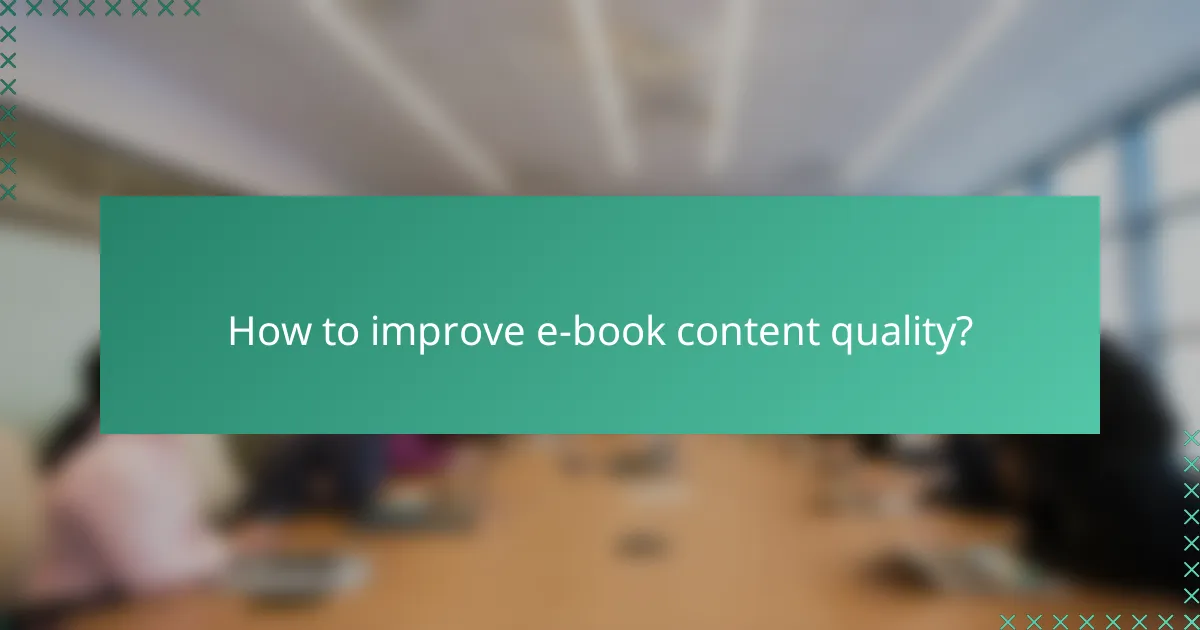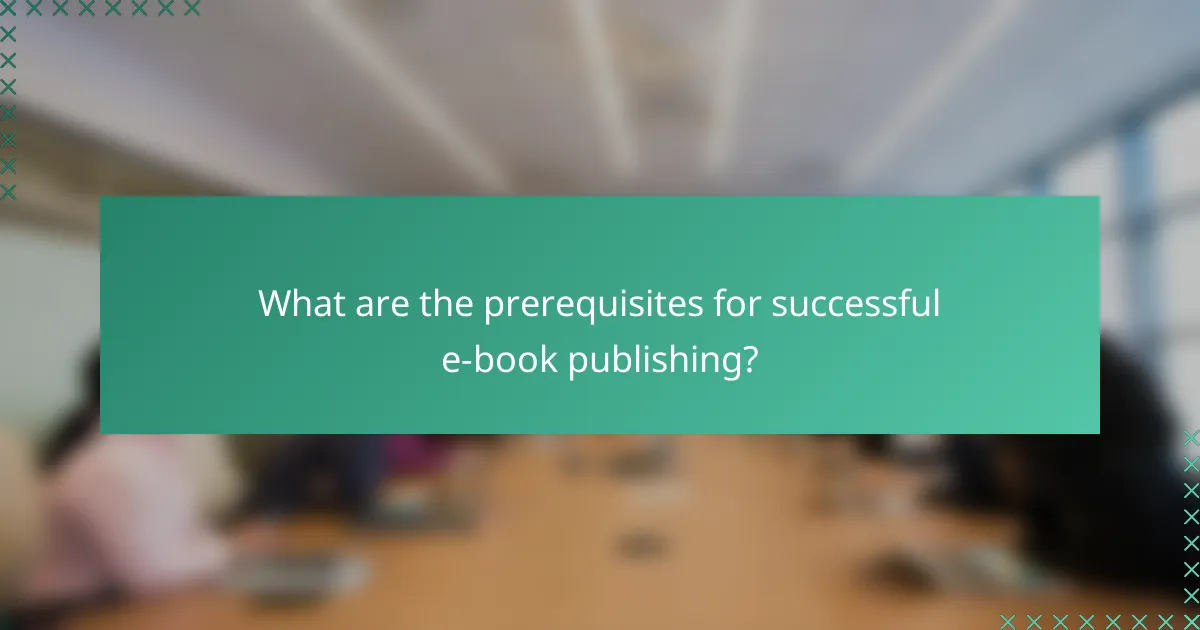The e-book market is increasingly competitive, with a growing number of titles leading to market saturation and challenging visibility for individual authors. To succeed, it is crucial to focus on content quality by enhancing clarity and engagement through professional editing and feedback. Additionally, pricing strategies must carefully balance consumer expectations and market dynamics to attract readers while maintaining profitability.

How to improve e-book content quality?
Improving e-book content quality involves enhancing clarity, coherence, and engagement to meet reader expectations. Key strategies include professional editing, incorporating feedback, and adhering to formatting standards.
Utilize professional editing services
Hiring professional editing services can significantly elevate the quality of your e-book. Editors can provide insights on structure, grammar, and style, ensuring your content is polished and free of errors.
Consider using services that specialize in e-books, as they understand the unique requirements of digital formats. Budgeting for editing can range from a few hundred to several thousand dollars, depending on the length and complexity of your work.
Incorporate reader feedback
Gathering and incorporating reader feedback is crucial for enhancing e-book content. Early readers or beta testers can provide valuable insights into what resonates and what doesn’t.
Utilize surveys or direct communication to collect opinions on clarity, engagement, and overall satisfaction. This iterative process can help refine your content before the final release, increasing its appeal to a broader audience.
Adopt best practices in formatting
Proper formatting is essential for a professional e-book presentation. Adhering to best practices ensures that your e-book is visually appealing and easy to navigate across various devices.
Focus on consistent font usage, appropriate heading levels, and clear chapter breaks. Tools like ePub and MOBI formats are widely accepted, and ensuring compatibility with platforms like Kindle and Apple Books can enhance accessibility.

What are the pricing challenges for e-books?
Pricing challenges for e-books stem from market saturation, competition, and consumer expectations. Authors and publishers must navigate these factors to set prices that attract readers while ensuring profitability.
Understanding competitive pricing strategies
Competitive pricing strategies involve analyzing similar e-books in the market to determine optimal price points. This can include setting prices slightly lower than competitors or offering promotional discounts to entice buyers. For instance, if most e-books in a genre are priced between $2.99 and $9.99, positioning a new release at $4.99 could attract attention.
Additionally, bundling e-books or offering subscription models can enhance perceived value. For example, a subscription service might charge a monthly fee for access to a library of e-books, which can be appealing to avid readers.
Evaluating perceived value vs. cost
Perceived value plays a crucial role in e-book pricing, as readers often equate price with quality. If an e-book is priced too low, it may be perceived as inferior, while a higher price can suggest premium content. Authors should consider their brand and the expectations of their target audience when determining price.
To effectively balance perceived value and cost, authors can gather feedback through surveys or beta readers. Understanding what potential readers are willing to pay can help in setting a price that reflects both the quality of the content and market demand.

How does market saturation affect e-book sales?
Market saturation significantly impacts e-book sales by creating intense competition among authors and publishers. As the number of available titles increases, it becomes more challenging for individual e-books to stand out, which can lead to reduced visibility and sales for many authors.
Identifying niche markets
Finding niche markets is essential for e-book authors looking to thrive in a saturated environment. A niche market focuses on a specific audience with particular interests, allowing authors to target their content more effectively. For example, instead of writing a general self-help book, an author might focus on self-help for introverts, catering to a specific demographic.
To identify potential niches, consider exploring trends in reader preferences, analyzing popular genres, and examining gaps in existing literature. Tools like Google Trends or social media platforms can provide insights into what readers are currently interested in.
Strategies for differentiation
To differentiate an e-book in a crowded market, authors should focus on unique selling points that set their work apart. This could involve a distinctive writing style, innovative formatting, or incorporating multimedia elements such as audio or video. For instance, an interactive e-book that allows readers to engage with the content can attract attention.
Additionally, effective marketing strategies can enhance visibility. Building an author brand through social media, engaging with readers via newsletters, and utilizing platforms like BookBub for promotions can help increase an e-book’s reach. Authors should also consider pricing strategies, such as introductory offers or bundling multiple titles, to entice potential buyers.

What are the prerequisites for successful e-book publishing?
Successful e-book publishing requires a deep understanding of your target audience, a well-structured marketing plan, and high-quality content. These elements are crucial for standing out in a crowded market and ensuring your e-book reaches its intended readers.
Researching target audience needs
Identifying the needs of your target audience is essential for creating relevant content. Conduct surveys, engage in social media discussions, and analyze existing e-books in your niche to gather insights. Understanding demographics, preferences, and pain points can help tailor your e-book to meet reader expectations.
Consider creating reader personas that represent different segments of your audience. This can guide your content creation and marketing strategies, ensuring that you address specific interests and challenges faced by potential readers.
Developing a marketing plan
A solid marketing plan is vital for promoting your e-book effectively. Start by defining your goals, such as sales targets or audience engagement metrics. Utilize various channels like social media, email marketing, and partnerships with influencers to reach your audience.
Incorporate promotional strategies such as limited-time discounts or free sample chapters to entice readers. Monitor the performance of your marketing efforts and be prepared to adjust your tactics based on what resonates best with your audience. A flexible approach can significantly enhance your e-book’s visibility and sales potential.

How to leverage platforms for e-book distribution?
To effectively leverage platforms for e-book distribution, authors should focus on major online retailers that offer user-friendly self-publishing options. These platforms not only provide access to a vast audience but also come with tools to help manage pricing, marketing, and sales analytics.
Using Amazon Kindle Direct Publishing
Amazon Kindle Direct Publishing (KDP) is one of the most popular platforms for e-book distribution, allowing authors to publish their works directly to the Kindle Store. KDP offers a royalty structure where authors can earn up to 70% on sales, depending on the pricing and distribution choices.
When using KDP, consider enrolling in KDP Select, which provides additional promotional tools but requires exclusivity to Amazon for a period. Authors should also pay attention to formatting guidelines and metadata optimization to enhance discoverability.
Exploring Apple Books and Google Play Books
Apple Books and Google Play Books are alternative platforms that can broaden an author’s reach beyond Amazon. Apple Books allows authors to set their own prices and offers a royalty rate of around 70%, while Google Play Books provides flexible pricing options and promotional tools.
When distributing through these platforms, ensure that your e-book meets their specific formatting requirements. Additionally, consider using promotional strategies such as discounts or free book days to attract readers and boost visibility on these platforms.

What are the emerging trends in e-book publishing?
Emerging trends in e-book publishing include the growth of interactive formats, the rise of subscription-based services, and the integration of multimedia content. These developments are reshaping how readers engage with digital literature and how authors and publishers approach content delivery.
Growth of interactive e-books
Interactive e-books are gaining popularity as they enhance reader engagement through features like quizzes, animations, and clickable elements. This format allows readers to actively participate in the narrative, making the reading experience more immersive.
Publishers should consider the target audience when creating interactive content. For example, educational e-books can benefit from interactive elements that reinforce learning, while fiction might use them to deepen emotional connections with characters.
Rise of subscription-based models
Subscription-based models are becoming a significant trend in e-book publishing, allowing readers to access a vast library of titles for a monthly fee. Services like Kindle Unlimited and Scribd offer flexible reading options, appealing to avid readers who prefer variety over ownership.
Authors and publishers need to weigh the pros and cons of this model. While it can lead to increased exposure and readership, it may also result in lower royalties per book read. Understanding the subscription landscape is crucial for maximizing earnings.
Integration of multimedia content
The integration of multimedia content, such as audio, video, and interactive graphics, is transforming traditional e-books into rich media experiences. This trend caters to diverse learning styles and can enhance storytelling by providing additional context or entertainment.
When incorporating multimedia, it’s essential to ensure that the content is relevant and adds value to the reading experience. For instance, a travel e-book might include video clips of destinations, while a cookbook could feature cooking demonstrations. Balancing quality and file size is also key to maintaining accessibility across devices.
